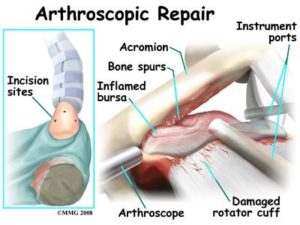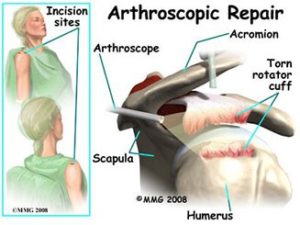Arthroscopy –A brief Introduction
Arthroscopy is a surgical procedure that lets a doctor look inside your joints. The doctor uses a thin viewing tool called an arthroscopy, or scope. It allows the doctor to see the joint surfaces and the tough tissue that covers and cushions the ends of the bones (cartilage). The doctor can also see the surrounding soft tissues, such as tissue that connects bone to bone (ligaments).
This procedure can be used to see if you have a joint problem or to do surgery that repairs a joint problem. It can also be done to remove a loose or foreign object in a joint. Doctors can also do it to keep track of a disease or to see how well a treatment is working. Arthros copy is most often done on the knee, shoulder, and ankle. It also can be done on the hip, elbow, and wrist.
copy is most often done on the knee, shoulder, and ankle. It also can be done on the hip, elbow, and wrist.
During arthroscopy camera.gif, the arthroscopy is put into your joint through a small cut (incision) in the skin. The scope has a light source and a video camera attached to it. Images from the camera can be seen on a video screen. These magnified images provide a clear picture of your joint. During the procedure, a sample of joint tissue can be collected to be tested. This is called a biopsy. If needed, more tools will be put into your joint through other small incisions.
Techniques to be used
The technique of arthroscopy involves inserting the arthroscope, a small tube that contains optical fibbers and lenses, through tiny incisions in the skin into the joint to be examined. The arthroscope is connected to a video camera and the interior of the joint is seen on a television monitor. The size of the arthroscope varies with the size of the joint being examined. For example, the knee is examined with an arthroscope that is approximately 5 millimetres in diameter. There are arthroscopes as small as 0.5 millimetres in diameter to examine small joints such as the wrist.
If procedures are performed in addition to examining the joint with the arthroscope, this is called arthroscopic surgery. There are a number of procedures that are done in this fashion. If a procedure can be done arthroscopic ally instead of by traditional surgical techniques, it usually causes less tissue trauma, may result in less pain, and may promote a quicker recovery.
Why it’s used
An arthroscopy might be recommended if you have problems such as persistent joint pain, swelling or stiffness, and scans have not been able to identify the cause.
An arthroscopy can also be used to treat a range of joint problems and conditions. For example, it can be used to:
- repair damaged cartilage
- remove fragments of loose bone or cartilage
- drain away any excess fluid
- Treat conditions such as arthritis, frozen shoulder or carpal tunnel syndrome.
Preparing for surgery
Before having an arthroscopy, you’ll usually be given an appointment to attend a pre-admission clinic.
During your appointment, your general health will be assessed to make sure you’re ready for surgery. You’ll also be given information about issues such as:
- what and when you are allowed to eat and drink on the day of surgery
- whether you should stop or start any medications before surgery
- how long it will take for you to recover from surgery
- whether you will need to do rehabilitation exercises after surgery
The surgical team will explain the benefits and risks associated with having an arthroscopy. You will also be asked to sign a consent form to confirm that you agree to have the operation and that you understand what’s involved, including the risks and benefits.
What happens during an arthroscopy?
The arthroscope is inserted through a small cut in the skin made next to the joint. Further small incisions may also be made to allow an examining probe or surgical instruments to be inserted.
Your surgeon will then examine the inside of the joint using the arthroscope and, i f necessary, remove or repair any problem areas.
f necessary, remove or repair any problem areas.
This will usually be done under general anaesthetic, although sometimes a spinal or local anaesthetic is used.
The procedure is usually performed as a day case, which means you’ll normally be able to go home on the same day as the surgery.
Recovering from an arthroscopy
The time it takes to recover from an arthroscopy can vary, depending on the joint involved and the specific procedure you had.
It’s often possible to return to work and light, physical activities within a few weeks, but more demanding physical activities such as lifting and sport may not be possible for several months.
Your surgeon or care team will advise you how long it’s likely to take to fully recover and what activities you should avoid until you’re feeling better.
While you’re recovering, you should contact your surgical team or GP for advice if you think you may have developed one of the complications mentioned below.
How It Feels
If you get a local anesthetic before the procedure, you will feel a brief burning or stinging in your skin. As the arthroscope is put into the joint, you will notice a thumping feeling. You may feel slight pulling in the joint area as your doctor moves joint structures around.
If you get a general anesthetic, you will be asleep and will not feel anything. If you get a regional anesthetic, your arm or leg will be numb for several hours.
You may have some soreness and pain after the procedure. Your doctor will give you instructions on using pain medicine and applying ice to your joint to reduce swelling and pain. You may also need to prop it up on pillows. You will have bandages to cover your incision. Keep them clean and dry.
After the procedure, you may notice bruises around the incision. This will not last long and should disappear within 2 weeks. It is normal for your joint to feel tender for about a week. Ask your doctor how much bleeding, drainage, or swelling from the incision site to expect. If you needed more extensive joint surgery, you may have more bleeding, drainage, pain, and swelling than if you had a simpler surgery.
What are the risks?
An arthroscopy is generally considered to be a safe procedure, but like all types of surgery it does carry some risks.
It’s normal to experience short-lived problems such as swelling, bruising, stiffness and discomfort after an arthroscopy. These will usually improve during the days or weeks following the procedure.
More serious problems are much less common, occurring in less than 1 in 100 cases. They include:
- a blood clot that develops in one of the limbs – this is known as deep vein thrombosis (DVT) and it can cause pain and swelling in the affected limb
- infection inside the joint – this is known as septic arthritis and it can cause a high temperature (fever), pain and swelling in the joint
- bleeding inside the joint – which often causes severe pain and swelling
- accidental damage to the nerves that are near the joint – this can lead to numbness and some loss of sensation, which may be temporary or permanent
- Speak to your surgeon about the possible risks before agreeing to have an
After the test
Contact your doctor right away if:
- Your pain or swelling (or both) continue or get worse.
- Your incision site bleeds more than expected.
- You have redness, swelling, pain, or a feeling of heat in your calf or arm. These may be signs of a blood clot in a vein. This condition is called thrombophlebitis. If you have these symptoms, do not massage the area.
You develop signs of infection. These signs may include:
- Increased pain, swelling, redness, or warmth around the affected area.
- Red streaks extending from the affected area.
- Drainage of pus from the area.
- Swollen lymph nodes in the neck, armpit, or groin.
- Fever or chills with no other known cause.
Recovering from an arthroscopy
How long it takes to recover after an arthroscopy can vary, depending on the type of surgery you had, your general health and the type of work that you do.
Some people feel better after a few days, while others may not be back to normal for several months.
Recovery advice
It’s likely that you’ll feel tired and light-headed after having a general anaesthetic, so you’ll need to ask a responsible adult to take you home and to stay with you for the first 24 hours following surgery. Most people will recover from the effects of the anaesthetic within 48 hours.
Make sure you elevate the joint and apply ice packs to help with swelling when you get home, if advised to do so. You should also carry out any joint exercises that have been recommended for you.
Any dressings will need to be kept as dry as possible, so you’ll need to cover them with a plastic bag when having a bath or shower. If your dressings do get wet or fall off, they will need to be replaced. The dressings can usually be removed after 5 to 10 days.
Your wounds should start to heal within a few days. If non-dissolvable stitches were used to close them, these will need to be removed after a week or two. This will usually be done by a practice nurse at your local GP surgery.
You’ll normally be asked to attend a follow-up appointment a few weeks after the operation to discuss the results of the surgery, your recovery, and any additional treatment you may require.
Returning to normal activities
Your surgeon or care team will advise you how long it’s likely to take to fully recover and what activities you should avoid until you’re feeling better.
You’ll probably need at least a week or two off work, although this varies from person to person – some need more, while others need less. This will largely depend on whether your job involves strenuous activity that could damage the joint.
You’ll be able to drive again once you’re able to do so without experiencing any pain and you can safely perform an emergency stop. This may not be for a few weeks or several months after surgery. Your surgeon can give you more specific advice.
Your surgeon can advise you on how long it will be before you can undertake strenuous physical activities, such as heavy lifting and sport. For many people, this will be around six weeks after surgery, but in some cases it may not be for several months.
